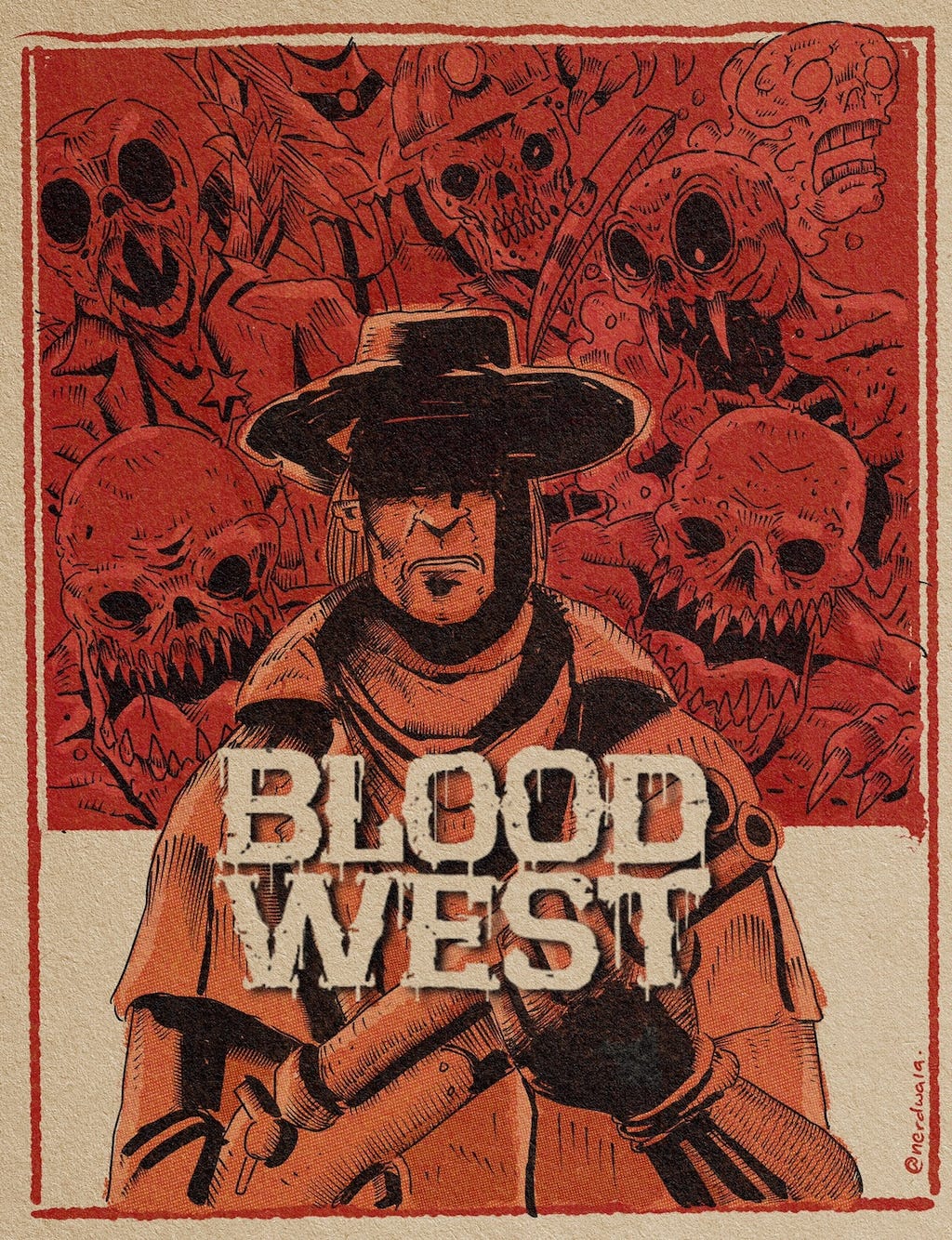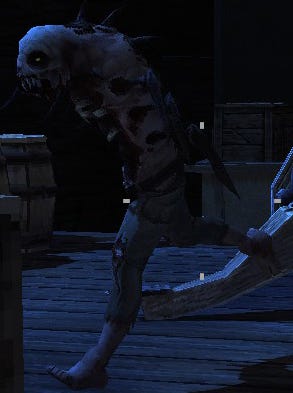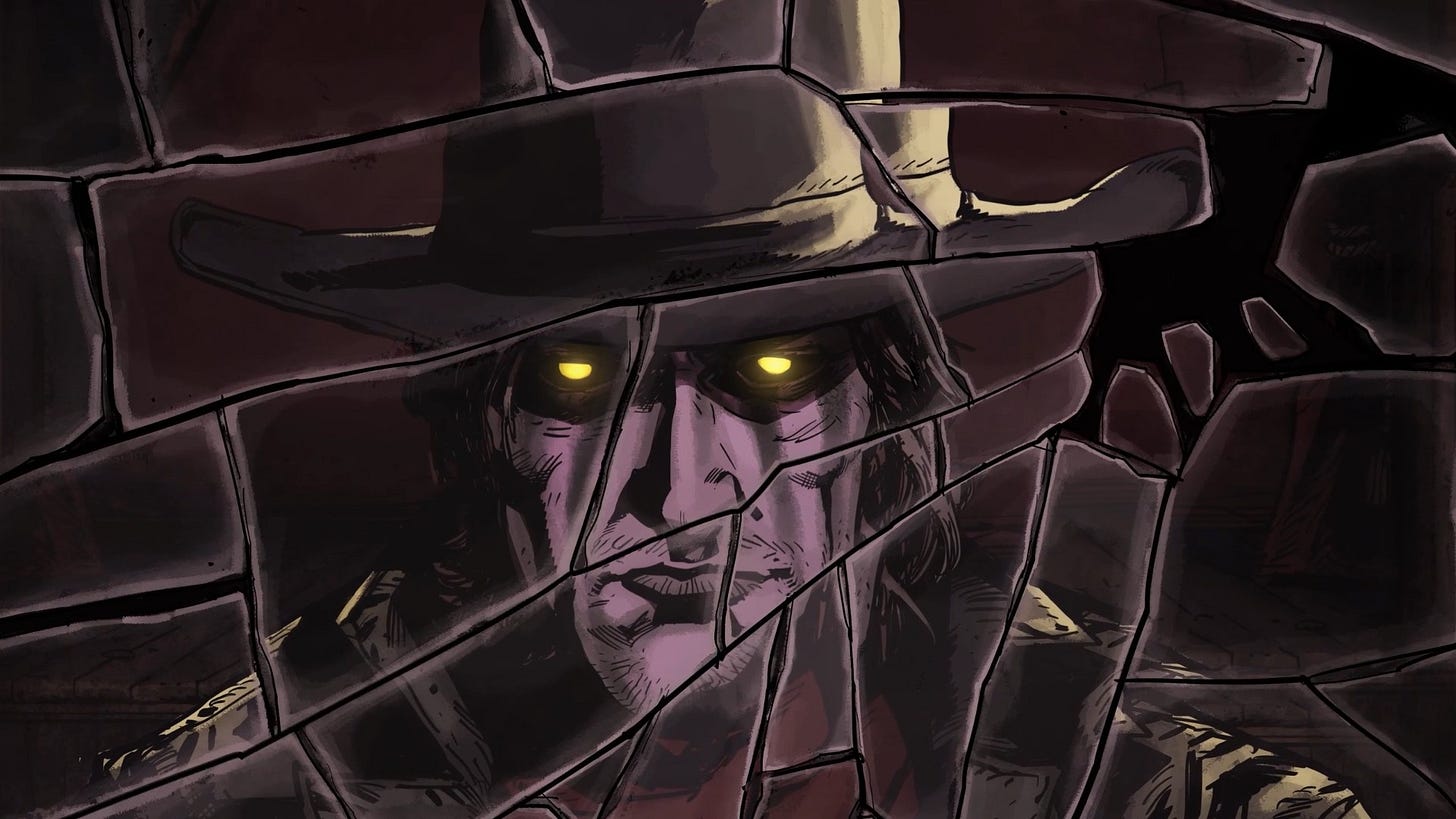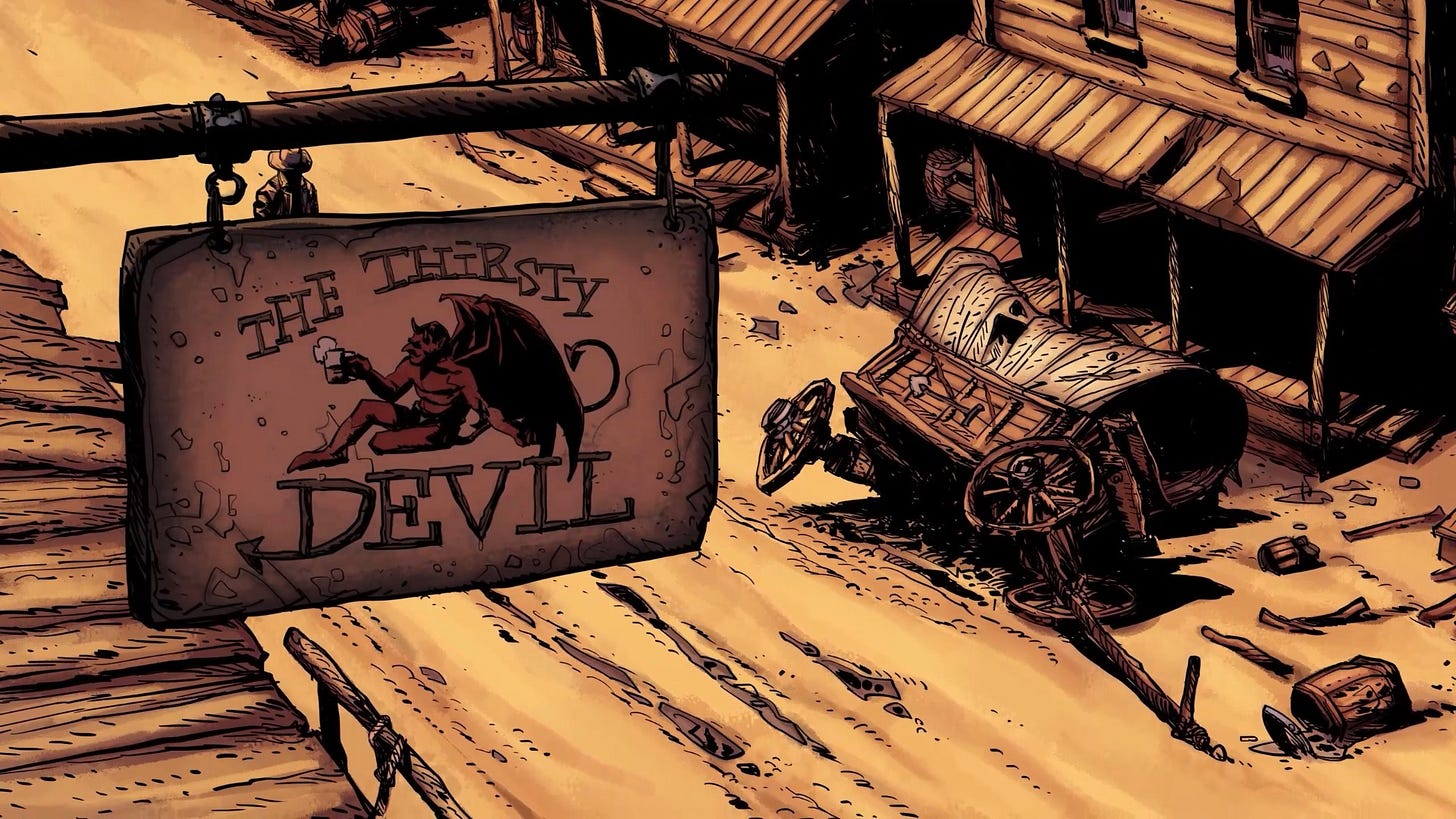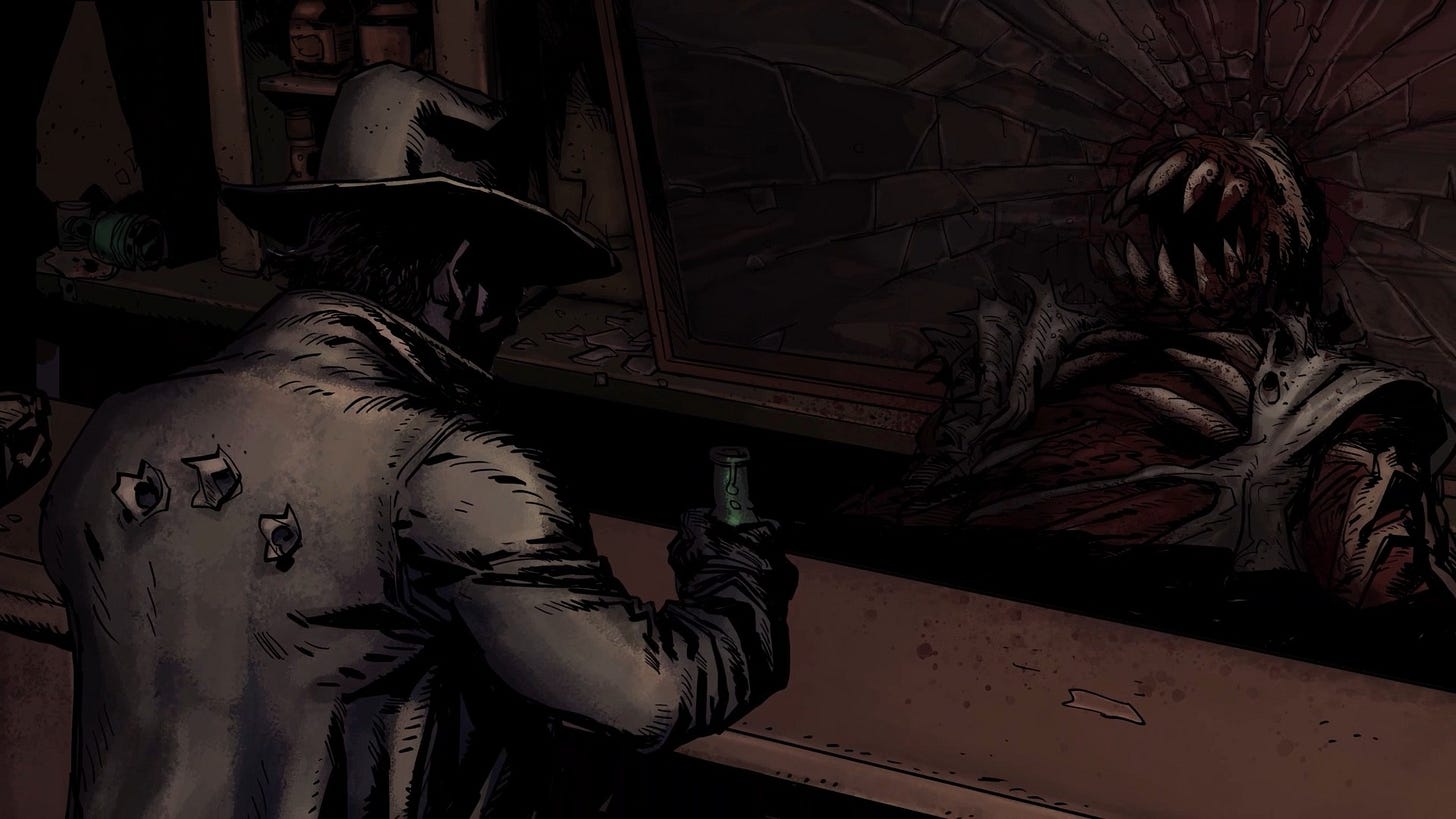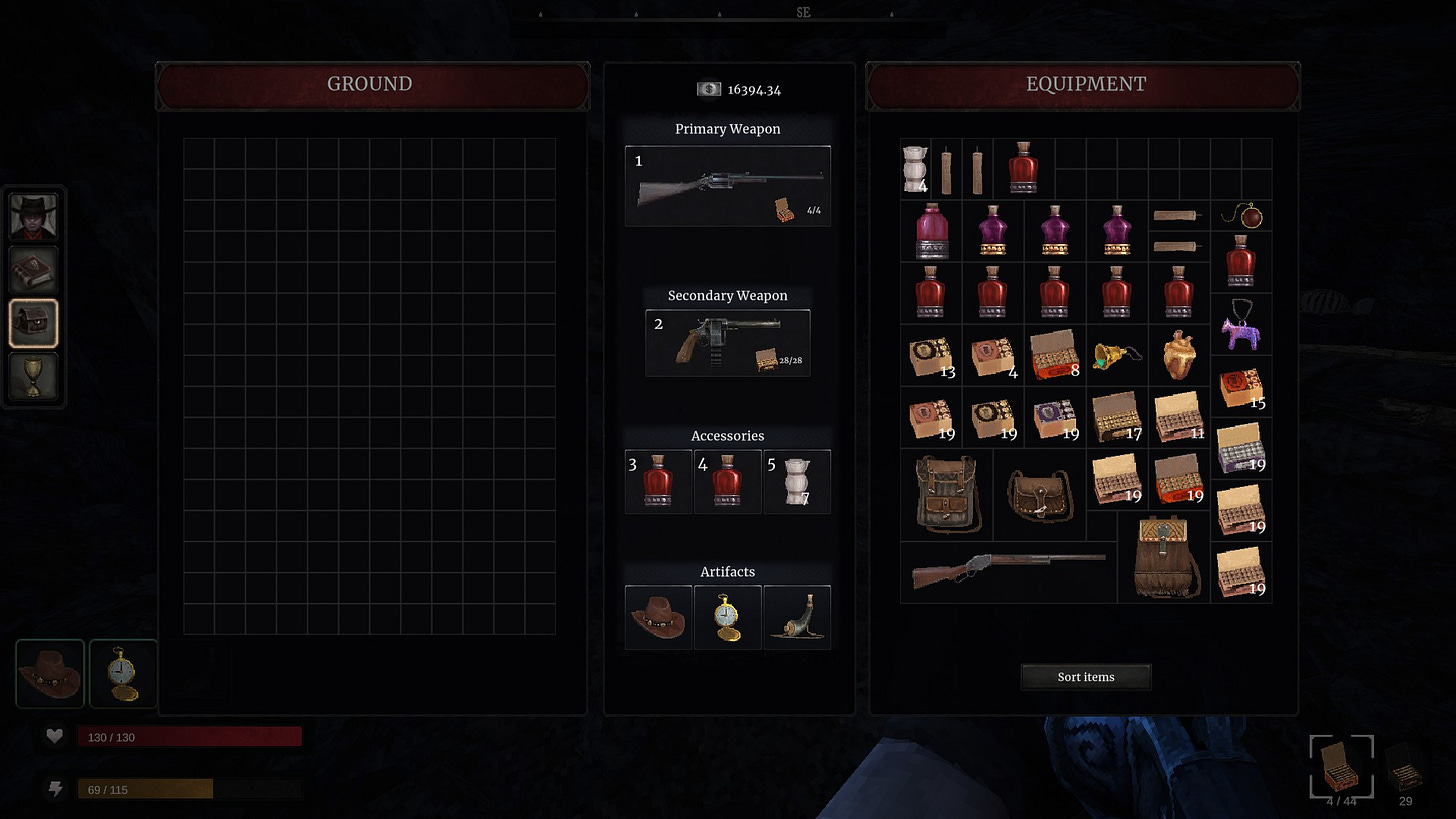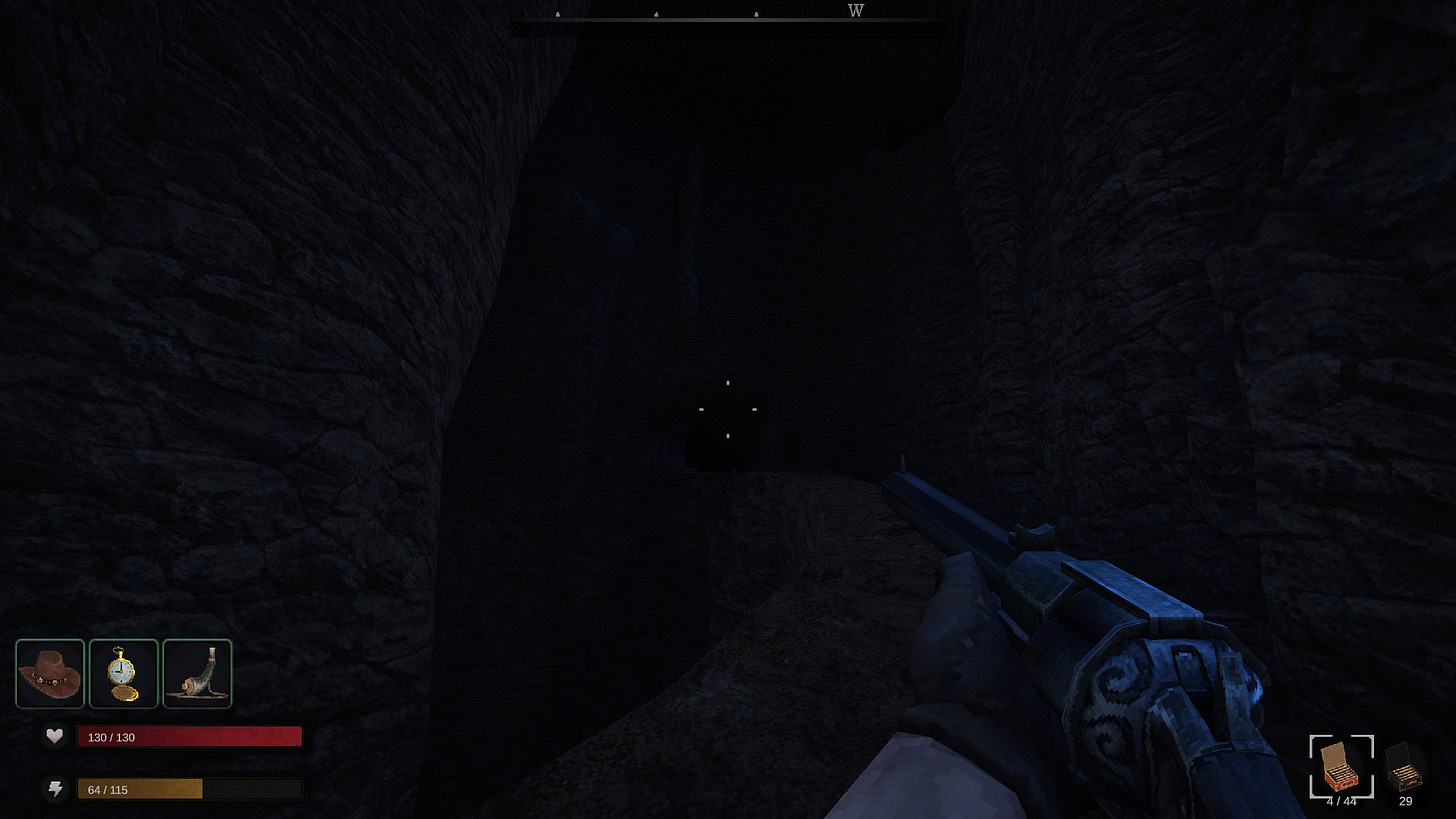Nearly two years ago I reviewed the first chapter and Early Access version of Blood West, a weird Western Immersive Sim-like. I avoid EA games as a general rule and strenuously avoid reviewing anything still in beta, but I made a sole exception for Blood West. That original release in February of 2022 was polished, tight, and glorious; it gave me everything I wanted out of the intersection between my favorite genre of fiction and my favorite style of video game. Chapter 1 alone was my GotY last year.
The full game was supposed to release by October 2022. Instead, only Chapter 2 came out, and on Halloween—they cut it rather close.
Chapter 2 was not my GotY. I made it to the end on three occasions, and every time my save file was corrupted in one way or another. On my first attempt I made it to the chapter’s boss, only to find him stuck in place and invulnerable. When I reloaded, every NPC in the game had disappeared. My second try was thwarted when I marathoned the whole game, both acts, then subsequently crashed a few minutes before summoning the boss. It was at this point that I learned Blood West keeps no autosaves. If you crash or the power cuts off and you haven’t exited the game once during your run, your entire save will be gone.
On my third try, I saved and quit after a few hours of play. Next morning, when I sat down to continue, I realized that the file had been eaten by Humanpedes. It was no longer in my Documents folder.
To say this experience soured me on Blood West would be to say far too little. But Early Access is Early Access, as they say, and while I contemplated venting my frustrations on this blog, I held off. I would wait until the game’s full release and amend my review then.
That was over a year ago. It has taken thirteen months (and a few days) for Chapter 3 to arrive, and with it comes the game’s full release. Now the gloves come off. I no longer will give any benefit of the doubt. It is time to determine whether or not Blood West has lived up to its promise and potential.
What’s Different?
Most of everything written in my pre-review stands. Almost nothing has changed in the map and mechanics, which reflects back on the immense polish with which Blood West first entered Early Access. The skill system has been revamped and safes have been added to the map, but that’s all that I noticed. The biggest difference is narrative; the voice of the protagonist has been replaced with Stephen Russel (he of Thief fame, among many other games).
I praised the original VA extensively last time. His gruff, laconic commentary on the gameplay elevated Blood West from great to excellent. It is very sad to see him go. I love Russel, but he doesn’t compare. His performance is exaggerated and almost gonzo. The lines also seem different, and they play far too often compared to before (although line frequency can be changed in the options menu).
The old actor was much better for the part.
Chapter 1 remains otherwise phenomenal. Every pixel of the map is packed with something to find. The encounters are brilliantly designed, and the atmosphere captures the smell, the scent, and the taste of choking on traildust—plus monsters—as well as any game ever will. Taken on its own, this may be the best Western game ever made, and would make a brilliant stand-alone pocket ImSim. Chapter 1 is worth the $20 price tag.
As for the rest…
One of my concerns in Early Access was how, possibly, an Immersive Sim such as this one would be able to protract its progression schemes to such an extent that it could be tripled in length. That puts it on par with any AAA ImSim, easily. Would there be enough new guns? Enough new artifacts and skills? I wondered if the next two parts of this game could ever match up to what I’d already played.
I was right to be concerned. Chapters 2 and 3 are good, but they are thinly stretched. Neither recaptures what makes Chapter 1 so resplendent.
I criticized Early Access for being too easy near its end. To counterbalance this, the developers have nerfed many of the skills, vastly reduced the player’s upper health limit, and generally increased the game’s difficulty. Chapter 1 still feels fair, but 2 and 3 do not. Death often comes instantly after a small mistake, such as missing a headshot when attacking from stealth. Such deaths rarely feel earned.
I think Blood West was a stronger game overall, even if easier, when the player had access to a larger health pool and could take more hits before dying—and from dying, earn a Soul Flaw.
I was ambivalent on the death mechanics originally, but having now played the full game, I believe Soul Flaws to be completely pointless. Death is its own punishment now that enemies respawn on rest, and the strange way by which the Flaws compound creates bizarre incentives: you can’t get rid of a Flaw until it manifests as a Curse, which requires you to die three times. But each death along the way to the third has some minor detriment, while death otherwise has no consequences (except partial respawns). Thus the logical thing to do upon dying once is to go commit suicide three times, then talk to a totem.
I tried not to do this. Instead I stuck to removing my Flaws with Purple Revival from the traders, which basically makes the whole system trivial anyway.
I like that this system fits into the narrative. But I don’t like anything else about it.
More broadly, the Soul-like respawn system adds nothing to Blood West. Chapters 2 and 3 are both enormous compared to 1, but both only have a single totem. This is bizarre. The game would have been better off with quicksave functionality, like every other ImSim.
Ultimately the real consequence of death is that you have to run back across the map to where you were, killing and evading hordes of the same enemies, just to get to where you had been before making a small mistake—a missed shot, a wrong step, a bad ammo choice. This adds some weight to survival, I suppose, but while I appreciate the need for meaningful challenge in systems-driven games like these, the challenge of Blood West has no rhythm to it. The entire game is the same note: watch the detection meter, stealth kill monsters, aim for the head, repeat. The intensity never goes up or down. It’s always the same. There are no zones where exploration is safe, there are no puzzles, there’s no platforming, there are few environmental hazards: everything is about sneaking and killing.
Later in the game, when the enemies get too big and tanky to stealth kill with your knife, it’s mostly just a shooter—a lot like the recent System Shock.
That was fine when the game was only five hours long. But now, in total, it’s somewhere between twenty and thirty.
Blood West does not have the mechanical complexity of a thirty hour game. It starts to get frustrating somewhere in Chapter 2, and it doesn’t get fun again until late in Chapter 3, once you’ve unlocked the highest tier of weapons and artifacts. Then Blood West becomes a badass Western/horror FPS, and it’s great. But there’s a long slog in the middle that I did not enjoy. This is a classic example of an excellent game that has been stretched too thin.
Take the towns in the second and third chapters. In Chapter 1, there are a handful of locations with a handful of buildings. There’s something interesting everywhere. No building is empty, and when you stumble onto a new structure, you’ll feel a pang of excitement to see what’s inside. You know it will be good—or at least valuable.
The town in Chapter 1 has four or five buildings. That’s it. There’s a rare gun in the inn that almost anyone looking around will find. That’s also perfect.
The town in Chapter 2 has twenty buildings at least. If I found anything memorable in one of them, I can’t remember it. The good loot is all inside the nearby steamboat. You’ll feel compelled to explore every shop and apartment building lest you miss something valuable, but time after time, you won’t find anything at all. If there is real loot within one of those buildings, the chance that you miss it is extremely high.
This gets even worse in Chapter 3. In the various settlements there are rooms with literally nothing inside, except monsters.
If a room has no loot in a game like Blood West, it shouldn’t exist. I wasted hours (and hundreds of bullets) exploring copy-pasted, strangely box-shaped environments for almost no benefit.
Inventory management more broadly is one of the game’s major flaws. It’s inoffensive at first but becomes more murderous with each passing hour. By mid-Chapter 2 it is frustrating, and by the final boss, it is agony. Unlike Weird West, which had no interesting loot at all, Blood West is full of fun stuff to find and steal; this is why the game has such a strong drive to explore. But fumbling around with backpacks inside of satchels inside of backpacks is never fun, in any game. Swapping between weapons, playing inventory Tetris, rotating artifacts, replacing spent molotovs and dynamite in the “accessory” bar, moving ammo around, and fidgeting with the stash back at camp will take up a considerable amount of playtime, and ultimately could have been alleviated with more creative gameplay design.
I’ve played games with much worse inventory systems than Blood West, but what if, instead of 3 accessories, we could press: H for bandage, V for Molotov, G for dynamite, C for healing potions, and let us drink booze and revival mixes directly from the inventory?
The worst part of inventory management is consumables. They take up a lot of space while almost never being useful. Cigars and various alcohols always come, like in a Fallout game, with severe withdrawal symptoms—often so severe that there’s no choice but to stop playing for three minutes while they wear off. But the primary effects are never strong or long-lasting enough to warrant such detriments, and they become less worthwhile as you gain levels.
I really did not need these constantly cluttering the space I’d reserved for monster intestines.
And as for monster intestines, I realize that it’s less immersive, but couldn’t the monsters have simply carried cash instead of intestines that I have to lug back to traders every few minutes?
Small adjustments could have made massive quality of life improvements to the later stages of Blood West’s campaign.
The developers clearly felt like they needed more in each new part of their game. But they didn’t. Chapter 1’s strength is that the map is small and packed with fun stuff to see and kill, as I wrote last year. You walk five feet and you’re in the next area and there’s things to do—and then there’s an entire second map beneath the one you’re standing on!
Chapter 1 epitomizes depth in an open world game.
It wouldn’t be fair to call the rest of the game shallow, but the content is so much less dense. Moving between zones takes longer. The zones have comparable amounts of loot spread out within larger areas. Death is more frustrating. The quest objectives are fewer and farther between, and entire areas are devoid of mission goals (whereas every zone in Chapter 1 has gold to find somewhere—that structure is severely missed in Chapter 2 especially, where the story is extremely weak).
One gets the sense that an influx of cash at their EA release emboldened the developers to make their game bigger than they had first intended. That would explain why it took more than a year longer than first stated for the full release, despite minimal changes to core gameplay in that time. Personally, I wish they’d tried to keep their game small.
It Gets Better
I nearly gave up in early Chapter 3. But I’m glad I didn’t, because the game does get better. The late-game weapons—a revolving rifle, a chain revolver, and a lever action shotgun—are the pinnacle of cowboy violence in gaming. Combined with new artifacts, these weapons become obscenely powerful, and the relative squishiness of the player character becomes less of an issue. Retreading old ground is quicker and less frustrating when major enemies can be instakilled with a headshot and needn’t be sneaked past any longer. The side quests are compelling, and I was excited enough by the promise of new stuff that I endured the inventory systems and thoroughly looted the entire map in search of the best stuff.
I didn’t end up needing it. I had hoped the final boss would be a righteous onslaught of a million undead soldiers; I had hundreds of bullets saved up for this moment.
Instead, I found a purple dragon on a hill. I killed him instantly with two headshot criticals from my rifle.
Oops.
Conclusion
In the end, for what was my most anticipated release of the year, the full version of Blood West has me underwhelmed. It isn’t as good as it could have been. But it’s still a good game overall, and I’ll continue to recommend it far and wide. I haven’t offered much praise in this review, but that’s only because I offered so much in my last article—this is a less starry-eyed look at what is, ultimately, a small and ambitious indie game from Poland.
The game is too long. The chapters didn’t need to be as protracted as they are. I’m still not convinced there needed to be three chapters at all—two, with equal polish, and more time spent on systems, would have been good enough. But it’s doubtless that my experience was significantly sullied by my very bad time with Chapter 2 in Early Access, which caused me a good deal of extra frustration in my return to those same bayous that I don’t think most new players will find.
You should buy Blood West. It’s good, it’s cheap, it’s ridiculously long, and it’s probably the only Western Immersive Sim that will ever be made. It could have been better, but let’s just hope that gives a good excuse for HyperStrange to make a sequel.


